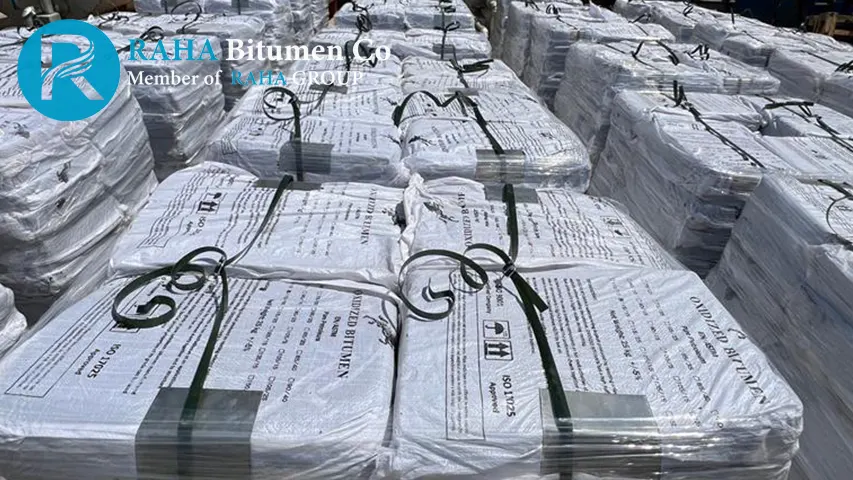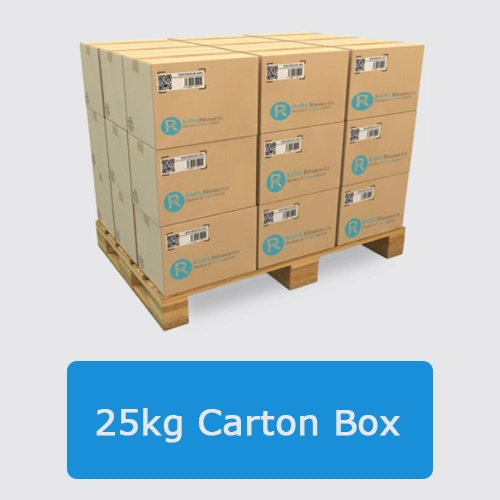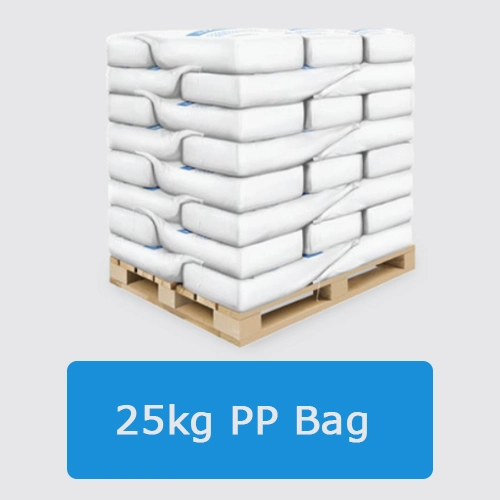
Oxidized Bitumen 90/40 is a type of petroleum-based bitumen that has undergone a unique refining process to enhance its properties and make it more suitable for various applications. This refined bitumen is a blend of hydrocarbons that are derived from crude oil and have been oxidized to create a highly viscous and sticky material. The “90/40” in the name refers to the bitumen’s penetration and softening point, respectively, which are key indicators of its quality and performance.
In addition to its impressive durability, Oxidized Bitumen 90/40 also boasts a range of other desirable properties. It has a high viscosity, which gives it excellent adhesion and bonding capabilities, making it ideal for use in conjunction with aggregate materials such as sand, gravel, and stone. It also has a relatively low softening point, which allows it to remain flexible and resistant to cracking even in extreme temperatures. This makes it an excellent choice for applications where temperature fluctuations are a concern, such as in roofing and waterproofing.
Description of Oxidized Bitumen 90/40
Oxidized Bitumen 90/40 is an oxidized Asphalt produced by oxidizing selected petroleum asphalts without adding the catalyst. Bitumen oxidized 90/40 has a high softening point, and high flash point and it is highly stable during melting.
This kind of Blown Asphalt is mostly used in the Mediterranean and especially in the Morocco market. Blown Asphalt 90/40 is produced by the air-blowing of penetration-grade bitumen. This is done at high temperatures, resulting in a material of a much higher penetration index.
Oxidized Bitumen is a solid or semi-black solid material and gradually liquid when heated. Oxidized Bitumen grades are blown or oxidized bitumen which are produced by passing air through soft bitumen under controlled temperature conditions. This process gives the bitumen more rubbery properties than penetration or hard-grade bitumen and a variety of uses in industrial applications.
Oxidized Bitumen 90/40 is produced by either a Continuous or Staggered Blowing Process. Heated Penetration Grade Bitumen under a controlled environment is blown with air which controls the Oil Content in the Bitumen while it oxidized. The different grades for suited applications produced are designated by two numbers to indicate the mid-points of their softening point and penetration ranges.
As said before, Oxidized Bitumen 90/40 is based on petroleum bitumen which is made by blowing bitumen 60/70 by very hot air. In addition, the numbers relate to the midpoint of the material’s softening point and penetration respectively. The softening point value was measured by the Ring and Ball method as determined by ASTM D36. Also, the penetration value is in 1/10 mm as determined by IP49 or ASTM- D5.
Technical Details of Oxidized Bitumen 90/40
This grade of Bitumen has too low penetration Although its softening point is lower than grade 115/15 In addition to penetration testing, there are tests used to determine Oxidized bitumen 90/40, including viscosity, shape, heat loss, and flash point. and the most important items are penetration and softening points.
According to the ASTM D36 method, the softening point of this grade of bitumen is between 85 and 95 ° C and the flash point is 250 ° C.
The Capability of Oxidized Bitumen 105/15
Uses of Oxidized Bitumen 90/40
There are many uses for this grade of oxidized bitumen but it is mainly used for industrial applications such as roof felts, waterproofing, roof and floor anti-rust pipe coating, anti-slip layer compound, sound dampening felts, coats for the automobile industry, joint filling compounds, sealants and bituminous mastic.
Oxidized bitumen 90/40 is used in chemical, fuel, paints, lacquers, varnishes, paper-pulp-board, textile processing, road construction, pavement, crack seals and repairs, civil works, roofing, construction industries; sealing and insulating buildings, adhesive, construction materials additive, dust-binding, insulating and impregnating agent, and also to manufacture rubber and plastic products. Oxidized bitumen 90/40 products are also used in asphalt-based paints for corrosion protection of metals, in lining public works structures, as adhesives in electrical laminates, base for synthetic turf.
Typical uses for oxidized bitumen 90/40 are for water-proof application and corrosion resistance for pipe coating, Portland cement pavement, hydraulic applications, paint manufacturing, caulking, mastics, and damp proofing. This grade of bitumen can be used for insulation and isolation in bitumen membrane sheets. It is also used in the automobile industry for car undercoating as it is proven to be an excellent water-proofing, dust proofing and also noise proofing material.
Advantages of Oxidized Bitumen 90/40 :
- High Purity Oxidized Bitumen (Oxidized Bitumen) without Using Gilsonite and any other impurities
- Excellent and permanent adhesive
- Low water absorption
- Chemically stable
- Flexibility
- Impact resistant
- High Resistant to soil stress
- High Resistant to cold stress
- High electrical resistance
- Quality assured manufacture.
- Conforms to ASTM standards with regards to softening point and penetration.
- Weatherproof oxidized bitumen packaging for flexibility of storage.
- Various Kind of Blown Bitumen packing according to Customer’s Purpose. (Meltable Bag, Kraft Bag, Carton Box, Block, Keg, Drum)
- Oxidized Bitumen meltable polyamide bag packages wrapping can be melted in conventional boilers without the need for removal
- Blown Asphalt Carton Boxes packing have non-stick insider layer that remove easily on Bitumen
Packing of Oxidized Bitumen 90/40
We are able to supply bitumen 90/40 in 25Kg meltable bag,50Kg meltable bag,25Kg craft bag,50Kg craft bag,25Kg carton box. In 20ft container, we can supply 22.8MT bulk or pallet. In case you are looking for drum packing it is possible in 185Kg Net and 220Kg drum.
Kind of Oxidized Bitumen 90/40 Packings
25kg Carton Box- Palletized and Shrink
Wrapped:
- Loading 880 Carton Box in 20ft Contai-
ner= 22 Ton Net

25kg PP Bag- Palletized and Shrink
Wrapped:
- Loading 920 Bag in 20ft Container= 23
Ton Net

Handling and Storage of Oxidized Bitumen 90/40
The heating of packaged bitumen is a critical phase in most of the final uses. Typically, the packaged material is heated and melted in boilers out on site.
However, control at the heating phase is very important in terms of health and safety as well as in maintaining the quality of the product.
A note must be taken of the maximum safe handling temperature of 230 C and this should not be abused. Bitumen is a poor conductor of heat, consequently, control of the heating phase is of paramount importance.
The Oxidized Bitumen material should be broken up prior to placement in the boiler. This exposes a larger surface area to the heat and encourages a more even heating regime.
Without the larger exposed surface area, aggressive heating at the base and sides of the boiler may well result in localized overheating, altering the characteristics of the modified bitumen, and potentially causing thermal cracking of the bitumen, creating the release of low lash vapors.
The flashpoint of the oxidized bitumen then becomes irrelevant; as these low flash vapors determine the fire risk.
Melted bitumen should not be left in the boiler and reheated from cold, as there is then a high potential for localized overheating around the heating area (lack of convection means poor heat transfer) and potential development of a pressurized pocket of low flash vapors.
Be aware of the placement of any temperature monitoring or control devices. As a result of the poor thermal conductivity of the bitumen, a thermometer in the bitumen some distance from the heat source could read significantly different (even hundreds of degrees) from the true temperature of the bitumen near the heat source. Blown asphalt 90/40 has 10 years of validity with multi-time heating and cooling.
Specification of Oxidized Bitumen 90/40
| Bitumen 90/40 | Test method | Unit | Specification |
|---|---|---|---|
| Specific gravity @25/25 C | ASTM D70 | (Kg/m3) | 1.05 approx. |
| Penetration @ 25°c | ASTM D5 | mm/10 | 35/45 |
| Softening point °c | ASTM D36 | °C | 85/95 |
| Ductility @25 °c | ASTM D113 | Cm | 5.5min |
| Loss on heating(wt) % | ASTM D6 | Wt. % | 0.2 max |
| Flashpoint c | ASTM D92 | °C | 250 min |
| Solubility is CS2(wt) % | ASTM D4 | Wt. % | 99.5 max |
| Spot test | A.A.S.H.O.T102 | — | Negative |


